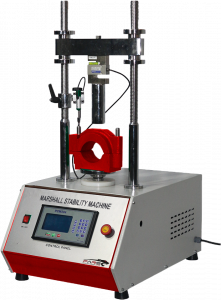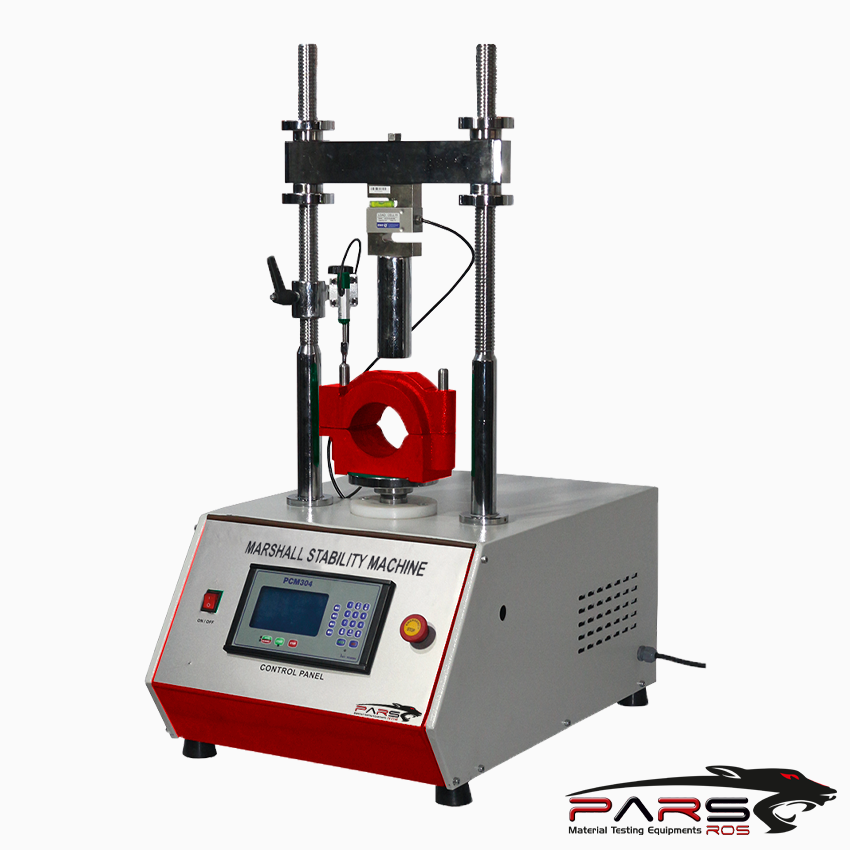Marshall Stability Test – Marshall Stability Test Machine
Marshall Stability Test Machine
Marshall Stability Test – flow test on bitumen and is applicable to hot mix design of bitumen and aggregates of maximum size 2.5 cm.
Bituminous concrete mix is commonly designed by Marshall Method.
Marshall Stability Test is extensively used in routine test programmes for the paving jobs.
The stability of the mix is defined as a maximum load carried by a compacted specimen at a standard test temperature of 600C.
The flow is measured as the deformation in units of 0.25 mm between no load and maximum load carried by the specimen during stability test
(flow value may also be measured by deformation units of 0.1 mm).
This test attempts to get the optimum binder content for the aggregate mix type and traffic intensity.
This is the test which helps us to draw Marshall Stability vs. % bitumen.

Test Procedure of Marshall Stability Test – Flow Test on Bitumen
The apparatus for the Marshall Stability test consists of the following:
Specimen mould assembly comprising mould cylinders 10.16cm diameter by 6.35cm height, base plate and extension collars.
Specimen extractor for extracting the compacted specimen from the mould.
A suitable bar is required to transfer load from the extension collar to the upper proving ring attachment while extracting the specimen.
Compaction hammer having a flat circular tamping face 4.5kg sliding weight constructed to provide a free fall of 45 cm.
Compaction pedestal consisting of a 20×20×45 cm wooden block capped with 30×30×2.5 cm MS plate to hold the mould assembly in position during compaction.
Mould holder is provided consisting of spring tension device designed to hold compaction mould in place on compaction pedestal.
Breaking head: this consists of upper and lower cylindrical segments or test heads having a inside radius curvature of 5 cm. the longer segment is mounted on a base
having two perpendicular guide rods which facilitate insertion in the holes of upper test segment.

It is provided with a gear system to lift the upward direction.
Pre-calibrated proving ring of 5 tonnes capacity is fixed on the upper end of the machine, specimen contained in the test head is placed in between the base and the proving ring.
The load jack produces a uniform vertical moment of 5 cm per minute.
Machine is capable of reversing its moment downward also.
This facilitates adequate space for placing test head system after one specimen has been tested.
Flow meter consist of guide, sieve and gauge.
The activating pin of the gauge slides inside the guide sleeve with a slight amount of frictional resistance. Least count of 0.025 mm is adequate.
The flow value refers to the total vertical upward movement from the initial position at zero load to value at maximum load.
The dial gauge of the flow meter should be able to measure accurately the total vertical moment upward.
In addition to above the following general equipments are also required:
Oven or hot plate
Water bath
Thermometers of range up to 200oC with sensitivity of 2.5oC and
Miscellaneous equipments like containers, mixing and handling tools etc.\



Leave a Reply
You must be logged in to post a comment.